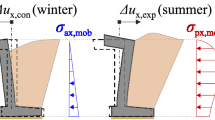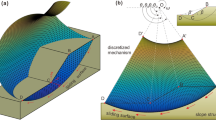Abstract
This study back-calculated moduli and shear strength of soils in London Canal Ave., New Orleans, using full-scale load test data, and re-evaluated the behavior of the I-wall to explore how the existing levees and floodwalls may be reliably retrofitted and future levees and floodwalls may be designed. From the back-calculation, it turned out that the moduli of the field soils were mostly higher (1–12 times) than magnitudes appeared in Interagency Performance Evaluation Task Force (IPET). But the shear strength of a water-glazed Marsh layer in the gap turned out to be substantially lower (0.2–0.25 times) than the magnitude appeared in IPET. This much strength reduction was confirmed by field vane shear tests: tests with artificial water infiltration into the field vane hole presented immeasurably low disturbed strength and resulted in very high sensitivity that might contributed to the failure. This study also shows that the gap development and strength reduction in the water-glazed Marsh layer are two main causes of levee failure, which have been predicted in previous research. The stiffer-than-expected moduli of underlain layers did not affect the failure mechanism of the levee substantially because these underlain layers remained elastic. Therefore, retrofitting solutions should be the ones that may prevent the gap development and to reinforce the Marsh layer.









Similar content being viewed by others
References
American Concrete Institute (ACI) (2005) Building code requirement for structural concrete (ACI 318-05) and commentary (ACI 318R-05). ACI Committee 318
Bowles JE (1996) Lateral earth pressure foundation analysis and design. McGraw-Hill, New York, pp 589–656
Brandon TL, Wright SG, Duncan JM (2008) Analysis of the stability of I-walls with gaps between the I-wall and the levee fill. J Geotech Geoenviron Eng 134(5):692–700
Conroy PJ, Berry KM (2008) Load test of London avenue canal floodwall. midwest levee conference, June 2–5, 2008, St. Louis, Mo
D’Appolonia DJ, Poulos HG, Ladd CC (1971) Initial settlement of structures on clay. J Soil Mechanics Found Div 97(10):1359–1377
Dunbar JB, Britsch LD III (2008) Geology of the New Orleans area and the canal levee failures. J Geotech Geoenviron Eng 1345:566–582
Duncan M, Brandon TL, Wright SG, Vroman N (2008) Stability of I-walls in New Orleans during Hurricane Katrina. J Geotech Geoenviron Eng 134(5):681–691
Foott R, Ladd CC (1981) Undrained settlement of plastic and organic clays. J Geotech Eng Div ASCE 107(8):1079–1094
Holtz RD, Kovacs WD (1981) Geotechnical engineering. Prentice-Hall, Englewood Cliffs, p 733
Hurricane Protection Office (HPO) of the US Army Corps of Engineers and the St. Louis District Corps of Engineers (2008a) The London avenue site specific load test final report of the Hurricane protection office of the US Army Corps of Engineers and St. Louis District Corps of Engineers. US Army Corps of Engineers, Washington, DC
Hurricane Protection Office(HPO) of the US Army Corps of Engineers and the St. Louis District Corps of Engineers (2008b) The London Avenue Site Specific Load test Appendix-D: analysis of the London avenue canal load test-section 1 soil structure interaction analysis, 1–17
Interagency Performance Evaluation Task Force (IPET) (2007) Performance evaluation of the New Orleans and southwest Louisiana hurricane protection system. Volume V. The Performance—Levee and floodwalls Final Rep. of the Interagency Performance Evaluation Task Force, US Army Corps of Engineers, Washington, DC <https://ipet.wes.army.mil/> (October 26, 2011)
Itasca Consulting Group (2006a) FLAC3D—fast Lagrangian analysis of continua in 3 dimensions. Version 3.1, Itasca, Minneapolis, MN
Itasca Consulting Group (2006) FLAC manual. Itasca, Minneapolis
Jackson RB (1988) E99 sheet pile wall field load test report. Technical report no. 1, US Army Engineer Division, Lower Mississippi Valley, June 1988, Vicksburg, MS
Jaky J (1944) The coefficient of earth pressure at rest. J Soc Hung Archit Eng 25:355–358
Ladd CC (1991) Stability evaluation during staged loading. J Geotech Eng ASCE 117(4):537–615
Oner M, Dawkins WP, Mosher R, Hallal I (1997) Soil structure interaction effects in floodwalls. Electron J Geotech Eng, 2
Seed RB, Bea RG, Athanasopoulos-Zekkos A, Boutwell GP, Bray JD, Cheung C, Cobos-Roa D, Ehresing L, Harder LF, Pestana JM, Riemer MF, Rogers JD, Storesund R, Vera-Grunauer X, Wartman J (2008) New Orleans and Hurricane Katrina.II: the central region and the lower ninth ward. J Geotech Geoenviron Eng 134(5):718–739
Seed RB, Bea RG, Athanasopoulos-Zekkos A, Boutwell GP, Bray JD, Cheung C, Cobos-Roa D, Ehresing L, Harder LF, Pestana JM, Riemer MF, Rogers JD, Storesund R, Vera-Grunauer X, Wartman J (2008) New Orleans and Hurricane Katrina.IV: Orleans East Bank (Metro) Protected Basin. J Geotech Geoenviron Eng 134(5):762–779
Sills GL, Vroman ND, Wahl RE, Scwanz NT (2008) Overview of New Orleans levee failures: lessons learned and their impact on National Levee Design and Assessment. J Geotech Geoenviron Eng 134(5):556–565
Terzaghi K (1943) Theoretical soil mechanics. Wiley, New York, pp 367–416
Ubila J, Abdoun T, Sasanakul I, Sharp M, Steedman S, Vanadit-Ellis W, Zimmie T (2008) New Orleans levee system performance during Hurricane Katrina: London avenue and Orleans canal south. J Geotech Geoenviron Eng 134(5):668–680
US Army Corps of Engineers (1994) Engineer Manual1110-2-2504: design of sheet pile wall geotechnical investigation, Washington DC, 3/1-3/11
Wang C, Salmon CG (1998) Reinforced concrete design. Introduction, materials, and properties. Addison-Wesley, Menlo Park, pp 1–31
Won J, Adhikari S, Song CR, Cheng AHD (2011) Evaluation of T-wall section in New Orleans considering 3D soil-structure interaction. J Geotech Geoenviron Eng 137(8):731–742
http://www.sheetpiles.net/ (December, 28, 2011)
Acknowledgments
The authors appreciate the funding received under a subcontract from the Department of Homeland Security-sponsored Southeast Region Research Initiative (SERRI) at the DOE’s Oak Ridge National Laboratory (Grant No.: 70023). The preparation of this manuscript is also partly funded by the National Research Foundation of Korea (NRF) grant (MEST: No. 2011-0030842).
Author information
Authors and Affiliations
Corresponding author
Rights and permissions
About this article
Cite this article
Adhikari, S., Song, C.R. & Cheng, A.HD. Evaluation of I-wall in New Orleans with back-calculated total stress soil parameters. Acta Geotech. 9, 1123–1134 (2014). https://doi.org/10.1007/s11440-013-0264-1
Received:
Accepted:
Published:
Issue Date:
DOI: https://doi.org/10.1007/s11440-013-0264-1




